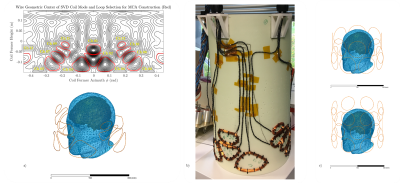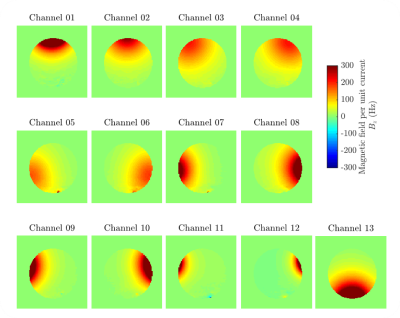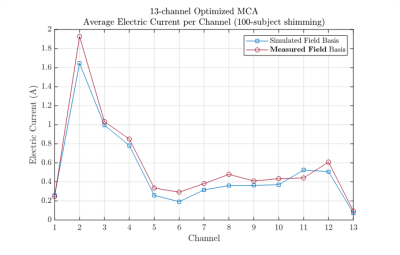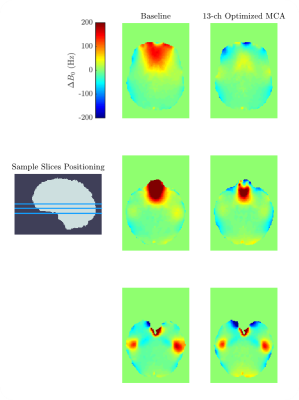0766
First prototype of a Stream-Function-based Multi-Coil Array dedicated to human brain shimming at Ultra-High-Field1Neurospin/CEA-Saclay, Gif-sur-Yvette, France, 2Université Paris-Saclay, Saclay, France, 3Athinoula A. Martinos Center for Biomedical Imaging, Charlestown, MA, United States, 4Harvard Medical School, Boston, MA, United States
Synopsis
Using Singular Value Decomposition of optimal Stream Functions computed from a database of 100 B0 fieldmaps, a 13-channel cylindrical optimized Multi-Coil Array for shimming of the human brain is built and tested in an experimental setup for field measurement at 7T. Such measurements are compared to expected performances, serving as proof of concept for this novel design methodology. Performance is compared to what would be achieved by matrix multi-coil array designs patterned on a cylinder.
Introduction
B0 field shimming of the human brain is essential, notably in Echo Planar Imaging (EPI), for artifact-less high-resolution 3D-acquisitions and NMR spectroscopy at ultra-high field. For improving B0 shim performance beyond the capabilities of standard 2nd-order shims included on conventional MRI scanners, Multi-Coil Arrays1,2,3 (MCA) have emerged as a promising tool in the past few years, as they are relatively easy to build, show improved performance on whole-brain shimming and can be rapidly switched to perform dynamic slice-by-slice4 shimming, further boosting shim performance. Such arrays are usually built by placing circular coil windings regularly distributed over a cylindrical surface, creating a matrix of channels1,3.For a more judicious choice of coil winding forms and placement, we previously showed a new method5,6 based on Singular Value Decomposition (SVD) of optimal Stream Functions7 (SF). In this approach, loops geometry and placement was optimized for mitigating whole-brain inhomogeneity, showing superior simulated performance to that of matrix MCAs (M-MCA) in whole-brain shimming while having reduced channel count.
In this work, a 13-channel Optimized MCA (O-MCA) prototype is presented; ΔB0 fields of each channel are measured in an experimental setup; the acquired fields are then used as a basis in brain shimming simulations for performance evaluation and comparison to expected results. The system is also compared to simulated M-MCAs.
Methods
For O-MCA design, a 100-subject database of three-dimensional ΔB0 brain fieldmaps was built from 1.7-mm isotropic 3T acquisitions in a Siemens Magnetom Prisma imager after global shimming with second-order SH coils. The ΔB0 field intensities were rescaled to 7T, since a shim system for UHF is intended. FSL’s brain extraction tool was used to exclude non-brain voxels, providing masks of 14.2-cm average length in foot-head direction. Each fieldmap was used as target field to calculate optimal SFs8 upon which the SVD is applied9. An optimized 13 loop array was extracted from the first SVD mode (cf. Fig 1a), each loop being associated with a shimming channel5 to be placed over a cylindrical coil former of length 300-mm and radius 140.5-mm.Single-turn models of the 13 loops were simulated in Ansys®-Maxwell to obtain estimated ΔB0 field maps and loop impedance. Expected global shimming performance over the database was computed using the simulated fields as shimming basis, considering now each loop with 20 turns to improve efficiency. Loops are made with 1-mm diameter copper wire in simulations and prototype.
The prototype was constructed by placing the 20-turn windings over an epoxy/fiberglass cylinder of 139.5-mm external radius and 4-mm thickness (cf. Fig. 1b). Using an open-source, low-budget, multi-channel current driver10, the magnetic field maps for each channel at 1.5A were acquired in a 198-mm-diameter cylindrical oil phantom on a MAGNETOM 7T Siemens scanner. Channel resistance was also measured for power dissipation estimations.
Agreement with predicted shim performance was assessed by inputting the measured fields per unit current as shimming basis for computational global shimming of the database.
Two M-MCAs of 16 and 24 twenty-turn circular loop channels over cylindrical formers of 140.5-mm are also simulated for comparison (cf. Fig. 1c).
Current amplitude is constrained to 3A per channel in all shimming simulations and power dissipation is estimated for all systems.
Results and Discussion
Measured ΔB0 field maps are shown in Fig. 2. Shimming simulations in Fig. 3 indicate that the measured magnetic fields generated by the built prototype agree well with simulations: the inhomogeneity reduction provided by the real system was 20.7%(6.5), very close to the expected reduction of 20.8%(6.6). In comparison to usual M-MCA, the 13-channel O-MCA outperforms a 24-channel M-MCA using only about half the number of channels, highlighting the effectiveness of the SVD-based optimization in generating MCA designs for whole-brain shimming.Average currents demanded by the prototype are slightly higher than the expected currents (cf. Fig 4). This results from the physical windings being distributed inwards with respect to the single-turn model loop, thus having less resulting magnetic moment per unit current then ideal single-turn loops.
Simulated power consumption in the loops based on measured fields and resistances is 1.2W in average, with maximum power consumption at 5.0W. While this power consumption is relatively low due to the large wire diameter used, total power consumption is expected to increase in future design, as more layers of channels will be added to the shimming system5,6.
Fieldmaps in Figure 5 show marked improvement in B0-homogeneity in the frontal lobe provided by the 13-channel Optimized MCA. Modest improvement is also seen above the ear channels. Both regions will further benefit from adding more optimized windings to the prototype, but we note that these localized B0-hotspots can not be fully corrected using sources outside the head due to fundamental limits imposed by Laplace’s equations.
Conclusion
A preliminary 1-layer 13-channel optimized MCA prototype was designed. The shimming efficacy of the O-MCA was evaluated using 100-subject database of brain field maps. Inhomogeneity reduction provided by the prototype was as expected, while currents per channel increased due to the actual winding distribution over the coil former, deviating slightly from ideal simulated loops. These initial results validate the design choices and serve as proof of concept of SF-SVD-based optimization for MCA designs.Acknowledgements
We would like to acknowledge the Leducq Foundation large equipement ERPT program.
We would also like to thank Florian Couly for his support on the preparation of part of the electronics system employed in this work.
References
1. C. Juchem, T. W. Nixon, S. McIntyre, V. O. Boer, D. L. Rothman, and R. A. de Graaf. Dynamic multi-coil shimming of the human brain at 7T. Journal of Magnetic Resonance 2011; 212(2):280–288.
2. J. P. Stockmann et al. A 32-channel combined RF and B0 shim array for 3T brain imaging. Magn. Reson. Med. 2016; 75(1):441–451.
3. A. Aghaeifar et al. Dynamic B0 shimming of the human brain at 9.4 T with a 16-channel multi-coil shim setup. Magn. Reson. Med. 2018; 80(4):1714–1725.
4. C. Juchem, S. Umesh Rudrapatna, T. W. Nixon, and R. A. de Graaf. Dynamic multi-coil technique (DYNAMITE) shimming for echo-planar imaging of the human brain at 7 Tesla. NeuroImage 2015; 105:462–472.
5. B. Pinho Meneses, M. Luong, and A. Amadon. Optimized multi-coil array design for human brain shimming at Ultra-High Field. Proc. ISMRM 2019; p.1477.
6. B. Pinho Meneses and A. Amadon. Static-magnetic-field shimming coil system for magnetic resonance imaging. European Patent 072081EP/EPR 2019.
7. G. N. Peeren. Stream function approach for determining optimal surface currents. Journal of Computational Physics 2003; 191(1):305–321.
8. B. Pinho Meneses and A. Amadon. The Dipole Boundary Method: a simple approach to compute stream functions for shim coil design. Proc. ISMRM 2019; p.1476
9. B. Pinho Meneses and A. Amadon. A novel few-channel coil design for human brain shimming based on stream function Singular Value Decomposition. Proc. ISMRM 2019; p.1483.
10. Nick Arango et al. Open-source, low-cost, flexible, current feedback-controlled driver circuit for local shim coils and other applications. Proc. ISMRM 2016; p.1157.
Figures




